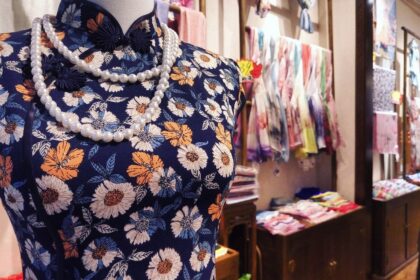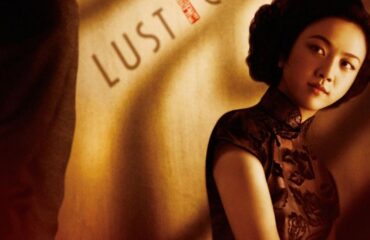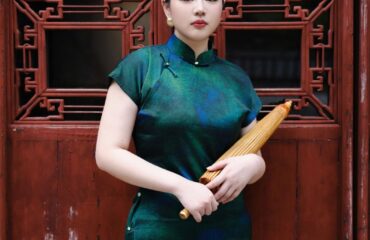
The cheongsam, or qipao, is more than just a dress; it is an icon of Chinese culture, a symbol of elegance, and a piece of wearable art. For a traveler in China, purchasing a cheongsam can be a highlight of the trip, a tangible memory that captures the beauty and tradition of the nation. However, the market is vast and varied, ranging from mass-produced tourist souvenirs to exquisite, handcrafted bespoke creations. Navigating this landscape can be daunting for the uninitiated. This guide is designed to equip you with the knowledge to discern quality, understand the nuances of style and fit, and ultimately find a cheongsam that you will not only wear but also treasure for years to come. Making an informed choice ensures your souvenir is not just a costume, but a genuine expression of classic Chinese aesthetics.
1. Understanding the Tiers of Purchase: RTW, MTM, and Bespoke
Your first decision will be determining the level of quality and customization you desire, which directly correlates with time and budget. Cheongsams in China generally fall into three categories: Ready-to-Wear (RTW), Made-to-Measure (MTM), and Bespoke.
| Category | Typical Cost | Time Required | Fit | Customization | Best For |
|---|---|---|---|---|---|
| Ready-to-Wear (RTW) | Low ($20 – $100) | Immediate | Standard Sizing | None | Quick souvenirs, budget-conscious travelers, a “fun” purchase. |
| Made-to-Measure (MTM) | Medium ($100 – $400) | 2-7 days | Semi-Custom | Fabric & some details | Travelers with a few days who want a good fit without a full custom process. |
| Bespoke (Custom-Made) | High ($400+) | 1-4 weeks | Fully Custom | Complete control | Those seeking an heirloom-quality garment, a perfect fit, and a unique design. |
RTW cheongsams are what you’ll find in most tourist markets. While convenient, they are often made from synthetic materials and their fit can be generic. MTM offers a fantastic middle ground, where you select a pre-existing design and have it tailored to your specific measurements. Bespoke is the ultimate experience, involving multiple fittings and complete control over every detail, from fabric selection to the style of the pankou (frog buttons).
2. Choosing a Style: Traditional Forms and Modern Interpretations
The cheongsam is not a monolithic design. Its style has evolved over the decades and varies by region. The two most famous traditional styles are the Shanghai and Beijing schools of thought.
- Shanghai Style (Haipai): This is the iconic, body-hugging silhouette that came to prominence in the 1930s. It is known for being more Westernized in its tailoring, designed to accentuate the female form. It is sleek, sensual, and often features high side slits.
- Beijing Style (Jingpai): This style is more traditional and conservative. It typically features an A-line or straight-cut silhouette, is less revealing, and often incorporates more elaborate embroidery and craftsmanship, reflecting its aristocratic roots.
Beyond these traditional forms, modern designers have introduced countless variations. You can find cheongsams with shorter hemlines for cocktail events, cap sleeves or sleeveless designs for summer, lower collars for comfort, and even versions made from denim or cotton for casual daily wear. Consider the occasion you intend to wear the dress for. Is it a formal event, or do you want something more versatile?
3. Fabric and Material: The Foundation of Quality
The fabric is the soul of the cheongsam and the most immediate indicator of its quality. A beautiful fabric will drape elegantly, feel luxurious against the skin, and hold its shape.
| Fabric | Common Use | Feel & Appearance | General Cost | Care |
|---|---|---|---|---|
| Silk Brocade | Formal, Traditional | Lustrous, stiff, with woven patterns | High | Dry Clean Only |
| Velvet | Formal, Winter | Rich, plush, deep color saturation | Medium to High | Dry Clean Only |
| Linen / Cotton | Casual, Summer | Breathable, comfortable, natural texture | Low to Medium | Machine or Hand Wash |
| Polyester / Rayon | RTW, Souvenir | Shiny, slippery, less breathable | Low | Machine Washable |
When inspecting a garment, touch the fabric. Real silk has a unique warmth and a subtle, pearlescent sheen, unlike the flat, synthetic shine of polyester. Linen and cotton are excellent for more casual, breathable cheongsams perfect for warmer climates. While synthetic blends are affordable and easy to care for, they lack the breathability and elegant drape of natural fibers and can look inexpensive.
4. The Importance of Fit: How It Should Look and Feel
A cheongsam is a tailored garment; its elegance is derived almost entirely from its fit. Even the most expensive fabric will look poor if the fit is wrong. When trying one on, pay close attention to these key areas:
- The Collar: The Mandarin collar should gracefully encircle your neck. It should touch your skin all the way around but not be so tight that it chokes you or restricts movement.
- The Shoulders: The shoulder seams should sit directly on the edge of your shoulder bones. If they droop down your arm, the dress is too big. If they pull inwards, it’s too small.
- The Bust and Darts: The dress should be snug across the bust without pulling or gaping at the buttons. The darts should point towards the apex of the bust, providing shape without flattening.
- The Armholes: You should be able to lift your arms comfortably without the whole dress riding up. There should be no significant gaping that reveals your undergarments.
- The Waist and Hips: A Shanghai-style cheongsam should skim your curves, accentuating your waist and hips without being constrictive. You should be able to sit down without fear of splitting a seam.
- The Side Slits: The slits are designed for ease of movement and to add a touch of allure. They should not be so high that they are overly revealing when you walk or sit.
5. Inspecting the Craftsmanship: The Devil is in the Details
Beyond fabric and fit, the small details of construction separate a fine cheongsam from a cheap imitation.
- Pankou (Frog Buttons): On a quality garment, these intricate knots are handmade from the same or a contrasting fabric, and are stitched on securely and evenly. On low-quality versions, they may be machine-made, asymmetrical, or even glued on.
- Piping and Binding: Look at the trim along the collar, cuffs, hem, and flap. It should be smooth, even, and meticulously stitched, especially around curves. Wavy or puckered piping is a sign of rushed work.
- The Zipper: Most modern cheongsams use a zipper, which should be discreetly hidden in a side seam or at the back. It should zip smoothly without catching on the fabric.
- Pattern Matching: This is a crucial hallmark of quality tailoring. If the fabric has a pattern (like a brocade or floral print), a good tailor will take the time to ensure the pattern aligns perfectly at the seams, creating an uninterrupted visual flow. Mismatched patterns are a clear sign of mass production.
- Lining: A high-quality cheongsam will almost always be fully lined. The lining (often a soft silk like habotai) makes the dress more comfortable, helps it hang properly, and conceals the inner seams for a clean finish.
6. Where to Buy: From Tourist Traps to Tailor Shops
China offers a spectrum of shopping experiences. In major cities like Shanghai, Beijing, Suzhou, and Hangzhou, you will find:
- Tourist Markets: Places like Shanghai’s AP Plaza or Beijing’s Silk Market are filled with vendors selling RTW cheongsams. You can find very low prices, and bargaining is expected. This is a good option for a fun, inexpensive souvenir, but do not expect high quality or natural fibers.
- Department Stores and Malls: Larger Chinese department stores often have sections with established local brands offering better quality RTW and sometimes MTM services.
- Specialty Cheongsam Boutiques: These shops focus exclusively on cheongsams. They offer a curated selection of RTW pieces and are often the best place to find MTM services. The staff are typically more knowledgeable.
- Bespoke Tailors: For the ultimate experience, seek out a dedicated tailor. This requires research and time. Cities like Shanghai are famous for their master tailors who have been crafting cheongsams for generations. Websites and resources dedicated to the art of the qipao, such as Cheongsamology.com, can be valuable for reviews and understanding the work of different renowned tailors before you even travel. A bespoke piece from a master is an investment in wearable history.
A cheongsam purchased in China is a connection to a rich cultural heritage. By moving beyond the first price you see and looking closer at the fabric, fit, and craftsmanship, you elevate your purchase from a simple souvenir to a beautiful, elegant garment. The search itself—feeling the different silks, admiring the hand-tied buttons, and seeing the dress take shape—is part of the unforgettable experience. Take your time, choose wisely, and you will bring home a piece of China’s timeless grace that you can wear with pride.


